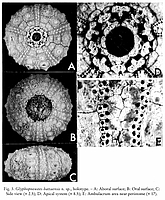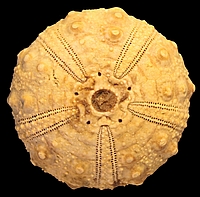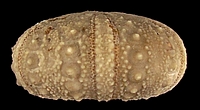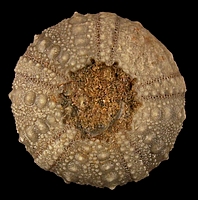Glyphopneustidae
Smith & Wright, 1993, p.210
Genre type : Glyphopneustes Pomel, 1883
Description succinte de la famille : Apex dicyclique, plaques ambulacraires composées de triades de pores de même type que chez bien des "Goniopygus", tubercules non perforés et non crénelés.

|
On séparera d'abord sous le nom de phyméchiniens un ensemble de genres ayant plus ou moins l'aspect des diadèmes, c'est-à-dire une forme peu élevée, d'assez gros tubercules semblables ou inégaux dans les deux aires, mais en général formant des séries verticales peu nombreuses, un péristome assez ample, anguleux, à lèvres peu inégales et avec des entailles très-nettes, mais peu profondes aux angles. Le test est dépourvu de sculptures et d'impressions suturales. Les uns ont les tubercules ambulacraires plus petits que les inter-ambulacraires, et les paires de pores en série unique droite ou peu ondulée. Ces pores sont 2-3 géminés et les tubercules sont crénelés chez les glyphopneustes (gonophiorus problematicus Cott.), et chez les vrais saléniens, qui devront un jour venir ici. Les tubercules sont lisses et les pores multigéminés chez goniopygus et acropeltis. D'autres genres ont les tubercules subegaux dans les deux aires et tous bien développés ; les pores ont une formule variable, trimultigéminés, unisériés ou plurisériés, soit dans toute l'étendue de l'ambulacre, soit seulement vers les extrémités. Dans phymosoma , coptosoma et micropsis, les tubercules sont crénelés comme dans glyptocidaris, qui se placera peut-être ici et possède seul des pores échelonnés en arcs transverses. Chez phymechinus et leiosoma les tubercules sont lisses. Enfin les tubercules, tout en étant encore subégaux dans les deux aires, sont atrophiés ou déformés au-dessus de l'ambitus ; les pores, en série continue, sont trigéminés partout, ce qui indique plus d'uniformité dans les tubercules de l'ambulacre avec des dimensions moindres ; ce sont les genres glypticus et clopleurus. |
![]()
|
Glyphopneustes hattaensis Ali,1992 - Maastrichtien, Simsima Fm, Jebel Buhays, Emirats Arabes Unis, 31 mm |
|
Glyphopneustes hattaensis Ali,1992 - Maastrichtien, Jebel Rawdah, Sultanat d'Oman, 21 mm coll. Joaquín Espílez |





